Triumph Trident History (1968-1975)
Article by Mark Trotta
During the 1950's and 1960's, twin-cylinder British motorcycles ruled on the track and on the streets, until demands from the U.S. market called for larger and more powerful bikes.
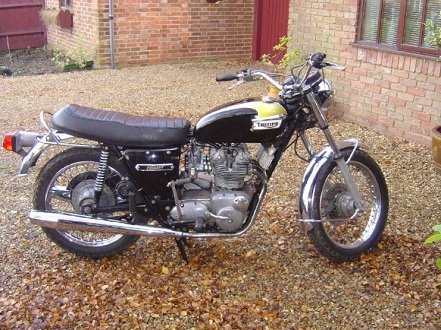
Beginnings
As early as 1962, Triumph and their parent company BSA were working collectively on a multi-cylinder engine design. The goal was a 750cc machine without the vibration associated with the parallel-twin design, and without the bulk of a four-cylinder layout.
The Trident/Rocket-3 was the first cooperative venture by BSA and Triumph since the companies merged in 1951.
By 1965, engineer Bert Hopwood and designer Doug Hele had a running three-cylinder prototype. Based on the existing parallel-twin, the OHV motor was slightly under-square, using a 67mm bore by 70mm stroke. The crankshaft rotated in the same direction as the wheels, with a primary drive chain connecting the crank to the multi-plate clutch. Final drive was also chain. Each cylinder had its own Amal carb, and the ignition system used three sets of points, each with its own coil.
_________________________________________________
_________________________________________________
Triumph Trident vs BSA Rocket-3
The BSA Company chose to produce their own version of the triple-cylinder bike, which used a different, forty-pound heavier frame. This delayed production of both models for over a year.
Both the Trident and Rocket-3 were available to the American market in 1969, the former keeping its single-downtube frame and holding the motor vertically, while the latter used a double-loop downtube, pitching the cylinders forward. Both bikes sported drum brakes front and rear.
Trident T150
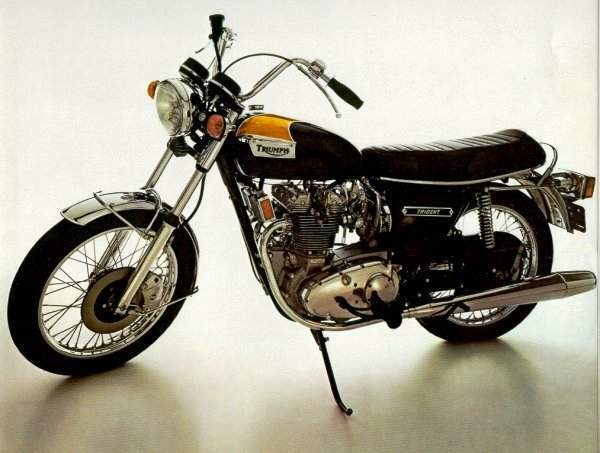
Producing 58 horsepower at 7250 rpm, the Triumph Trident could cover the standing quarter-mile in under 13 seconds, and reached a top speed of 115 mph. This new 500 pound "large-displacement touring machine" was regarded by many at the time to be the best road bike of all time - but not for long.
In the summer of 1969, Honda released its CB750-4, a motorcycle that had everything the American market was looking for: electric start, front disc brakes, five-speed gearbox, and left-side shift - all standard. This would be the beginning of the end for the British motorcycle industry.
Trident T150V
To compete with the influx of fast and affordable Japanese bikes, the Trident saw several upgrades. The four-speed transmission was upgraded to a five-speed, and the new model designation was T150V.
Front Disc Brake and Electric Start
For 1972, the front drum brake was replaced by a single 10-inch disc and Lockheed caliper. The previous drum brake worked well, but a disc system had much less brake fade.
Electric-start Tridents started appearing in late 1974 as 1975 models.
_________________________________________________
_________________________________________________
Trident T160
The T160 was the final carnation of the Triumph Trident. A new steel frame, whose design owed much to Triumph's successful factory production racers, had the Trident sharing the Rocket's forward-sloping cylinders. New front forks were slightly steeper and shorter, and pivoted on taper-roller steering head bearings.
Engine compression ratio was increased from 8.25:1 to 9.5:1, raising power output to 58 horsepower. Also new was the seat, side-panels, exhaust system, 5.8 gallon gas tank, and a longer swing-arm.
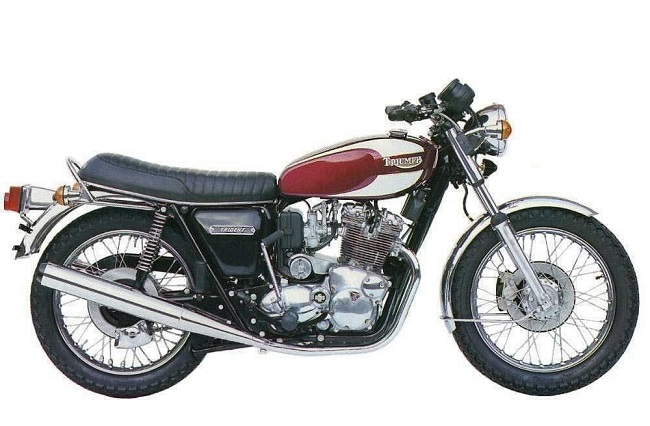
Whereas the T150 was kickstart only, the T160 was fitted with both kickstart and electric start.
Capable of 120+ MPH, the Trident T160 is regarded by many to be the definitive British superbike.
In all, over 27,000 Rocket3/Tridents were produced from 1968 to 1975.
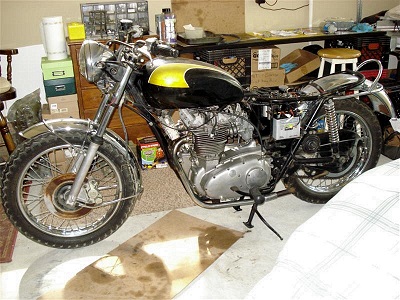
Related Article: 1974 Triumph Trident Build
***********************
Tridents On The Racetrack
Triumph Tridents were one of the most successful race bikes of their time, dominating 750cc races in Europe and in the United States.
At their first Daytona outing in 1970, Tridents took the top three qualifying speeds, with a top speed of 165.44 mph, and finished in second and third place. In the 1971 Daytona race, Tridents finished first, second and third. First place went to Dick Mann, who had won the year before on a Honda.
Subsequent racing seasons yielded many more victories at the hands of riders such as John Cooper, Ray Pickrell and Percy Tait. Trident Triples scored dozens of wins at Mallory Park, Brands Hatch, Le Mans, Talladega and Thruxton.
Perhaps the most famous racing Triumph was the production racer nicknamed 'Slippery Sam.' This race-prepared Trident took fourth place in its first year at the Isle of Man Production TT, and won first place in the next five consecutive Isle of Man races (1971 to 1975).
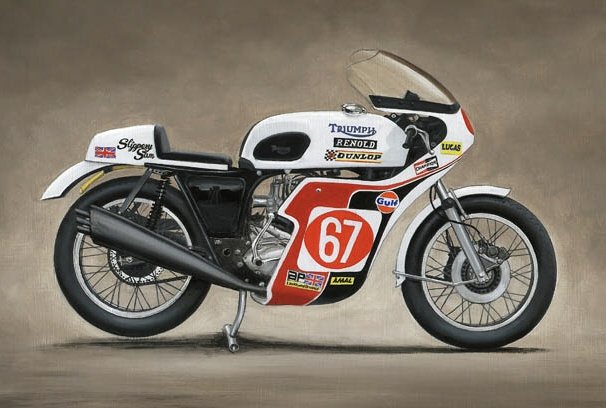
***********************
First Three-Cylinder Motorcycle
During the years 1899 through 1930, a French-based company called Buchet built engines for cars, motorcycles, aviation, and boats. Around 1903-1905, they offered a three-cylinder motorcycle. The "W3" configuration had each cylinder sharing the same crankshaft.
It is uncertain whether they manufactured the motor themselves, or it was built by the Anzani company, whose W3 engine appeared a little later.
An example of this early three-cylinder motorcycle can be seen here.
***********************
Related Articles: